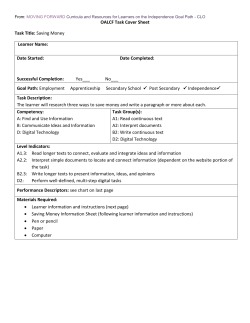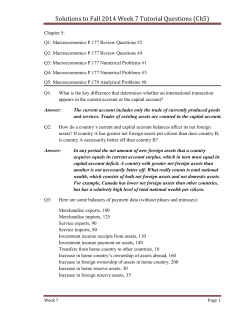
ECO 102 2nf Ass
Institute of Business Management Semester II Course Instructor: Date: 4/03/2015 Irfan Lal Total Marks:100 th Due Date: 26 March 2015 Assignment No.2 Q# 1 Explain why the saving curve slopes upward and the investment curve slopes downward in the saving investment diagram. Give two examples of changes that would shift the saving curve to the right, and two examples of changes that would shift the investment curve to the right. Q#2 You have just taken a job that requires you to move to a new city. In relocating, you face the decision of whether to buy or rent a house. A suitable house costs $300,000 and you have saved enough for the down payment. The (nominal) mortgage interest rate is 10°/o per year, and you can also earn 10°/o per year on savings. Mortgage interest payments are tax deductible, interest earnings on savings are taxable, and you are in a 30°/o tax bracket. Interest is paid or received, and taxes are paid, on the last day of the year. The expected inflation rate is 5°/o per year. The cost of maintaining the house (replacing worn out roofing, painting, and so on) is 6°/o of the value of the house. Assume that these expenses also are paid entirely on the last day of the year. If the maintenance is done, the house retains its full real value. There are no other relevant costs or expenses. a. What is the expected after-tax real interest rate on the home mortgage? b. What is the user cost of the house? c. If all you care about is minimizing your living expenses, at what (annual) rent level would you be just indifferent between buying a house and renting a house of comparable quality? Rent is also paid on the last day of the year. Q#3 Explain Desire Capital stock with the help of diagram? Q#4 6. An economy has full-employment output of 6000. Government purchases, G, are 1200. Desired consumption and desired investment are Cd == 3600 - 2000r + 0.10Y, and Id == 1200 - 4000r, where Y is output and r is the real interest rate. a. Find an equation relating desired national saving, sd, to r and Y. b. Using both versions of the goods market equilibrium condition, Eqs. ( 4.7) and ( 4.8), find the real interest rate that clears the goods market. Assume that output equals full-employment output. c. Government purchases rise to 1440. How does this increase change the equation describing desired national saving? Show the change graphically. What happens to the market-clearing real interest rate? Q# 5 Use the saving-investment diagram to analyze the effects of the following on national saving, investment, and the real interest rate. Explain your reasoning. a. Consumers become more future-oriented and thus decide to save more The government introduces an investment tax credit (offset by other types of taxes, so total tax collections remain unchanged). b. A large number of accessible oil deposits are discovered, which increases the expected future marginal product of oil rigs and pipelines. It also causes an increase in expected future income. Q#6 Explain Balance of payment and explain relationship between i) current account and capital account ii) current account and net export iii) Q#7 An economy has full-employment output of 9000, and government purchases are 2000. Desired consumption and desired investment are as follows: a). Why do desired consumption and desired investment fall as the real interest rate rises? b). Find desired national saving for each value of the real interest rate . c). If the goods market is in equilibrium, what are the values of the real interest rate, desired national saving, and desired investment? Show that both forms of the goods market equilibrium condition, Assume that output is fixed at its full-employment level. d). Repeat Part (c) for the case in which government purchases fall to 1600. Assume that the amount government purchases, to calculate the real interest rate that clears the goods market. What are the goods market-clearing values of consumption, saving, and investment? What are the taxadjusted user cost of capital and the desired capital stock in this equilibrium? Q#7 How would each of the following affect national saving, investment, the current account balance, and the real interest rate in a large open economy? a. An increase in the domestic willingness to save (which raises desired national saving at any given real interest rate). b. An increase in the willingness of foreigners to save. c. A temporary increase in government purchases. d. An increase in taxes (consider both the case in which Ricardian equivalence holds and the case in which it doesn't hold). Q#8 Explain Demand for money and Determinants of the Demand for money? Q#9 What do you understand by Money and function of Money? Q#10 Money demand in an economy in which no interest is paid on money is Md/p = 500 + 0.2Y - 1000i. a. Suppose that P = 100, Y = 1000, and i = 0.10. Find real money demand, nominal money demand, and velocity. b. The price level doubles from P = 100 to P = 200. Find real money demand, nominal money demand, and velocity
© Copyright 2025










